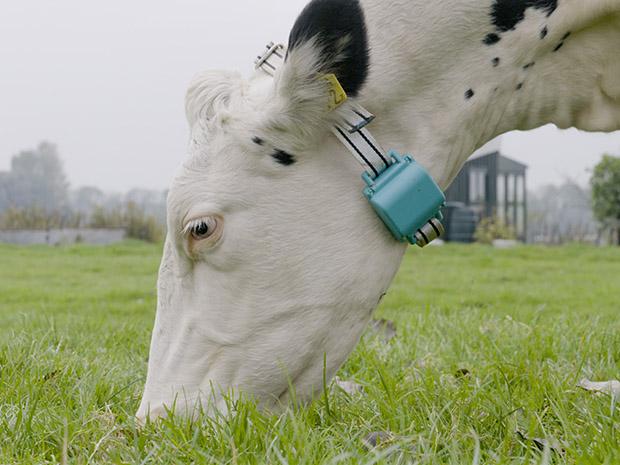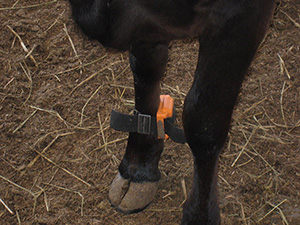Connected Cattle: Wearables are Changing the Dairy Industry

Dairy farming is a vital part of the economy in many countries. One key to profitability is getting the most cows pregnant during a breeding season. But knowing when a cow is in estrus—in heat—and ready for insemination can be tricky. The answer from at least two companies is simple: Outfit the cows with high-tech pedometers.
Estrus occurs every 21 days and lasts from 6 to 24 hours. Most dairy farmers look for the characteristics visually—difficult if the farmers are in charge of hundreds of cattle or if estrus occurs at night. If the signs are missed, there’s another 21-day wait. Miss them too many times and the cow might be sold for meat. For small farmers, that can be a significant loss, because selling the milk from cows that give birth is often their primary source of income.
To spot signs of estrus in a more automated way farmers are turning to cow-tracking systems. One of the most common indicators is that the cows walk more—some up to six times as much. A Fujitsu system counts steps, while another one from startup Connecterra also monitors the cows’ health. The two companies recently displayed their systems at separate events attended by IEEE. Fujitsu, Japan’s largest IT service provider, headquartered in Tokyo, demonstrated its support service for commercial farmers and breeders in February at the Mobile World Congress. Connecterra, a predictive analytics startup from Amsterdam, showed off its system for small dairy farms at theWeb Summit in November.
“This is not a very sexy industry; it’s not the next killer app,” says Saad Ansari, cofounder and chief technical officer of Connecterra. “But improving food manufacturing productivity is a real problem, and not a lot of people are working on it.”
Ansari, a computer scientist, says his company’s mission is to use data analytics to improve food production.
“By 2050, food output will have to be increased by 60 percent worldwide, so we started a venture that would lay the groundwork,” he says. “We really don’t need more cows; we need more milk from fewer cows.”

Most productive cows generate about 30 liters of milk per day during a lactation cycle. But dairy cattle in Pakistan, for example, yield only about 5 liters per day on average, because estrus is being missed or cows are sick or not eating enough.
Both companies are outfitting cows with pedometers, but they are going about it in different ways. Fujitsu charges up-front cost for its system. Connecterra’s equipment is free; it charges for its insights from the data it’s collecting.
About 5,300 head of cattle in Japan and South Korea are attached to Fujitsu’s cloud-based breeding system. Farmers in Poland, Romania, and Turkey are trying it, too.
Connecterra was launched a little more than a year ago. Several farms in the Netherlands and one in Pakistan are using its cloud-based service for cows outfitted with the company’s monitors.
Both companies use analytics to examine the data from their wearables. They charge the farmers for their analysis service as a subscription model known as SaaS, which functions remotely as a Web-based service.
BREEDING AIDE
Fujitsu calls its system Gyuho SaaS. The Japanese word gyuho is composed of two characters: Cow and step or walk. The company sells commercial farmers its tracking equipment, which includes a waterproof pedometer worn on the cow’s leg, a dipole antenna, and a receiver in the barn that sends information to Fujitsu. The company processes the data and displays it for the farmer via its cloud-based system. There are additional fees for operational support, setup, and training.
The number of steps is sent hourly to Fujitsu’s data center. The application can detect spikes in movement activity, an indicator that a cow is going into estrus and is ready for artificial insemination. The farmers can check the cow’s activity in one-hour increments from a computer or mobile device. They also receive system-generated notifications via email when the steps increase.
“Detecting cows’ estrus during the night or when the farmer is busy overseeing many heads of cattle is a substantial burden,” says Hidemitsu Takajima with Fujitsu Kyushu System’s Social Solutions Promotion Office, in Fukuoka. “Accurately ascertaining estrus and impregnating cows at the right time increases breeding efficiency.”
One farm using Fujitsu’s system has boosted its success rate of impregnating cows from 44 percent to 90 percent, Hidemitsu says.
INSIGHTFUL INFORMATION
Missing estrus isn’t the only problem for breeders. A cow’s health and diet also contribute to milk yield. Connecterra’s waterproof, shockproof trackers, which collect a variety of data, are simple but sturdy devices that go around a cow’s neck. Each consists of a three-axis accelerometer, a radio, and a hefty nonrechargeable battery with a long life. Using a deep learning–based system, the wearable tracks a cow’s steps and eating habits, and whether the animal is drinking enough water and chewing its cud, the partly digested food that the animal regurgitates from its stomach. That part of the digestion process is important to milk production.
The data collected is sent to a nearby base station that runs Linux. From there it is sent to the cloud. Connecterra doesn’t inundate the farmers with data; instead, it analyzes the cows’ behavior, using advanced mathematics and provides insights. Connecterra makes its money by offering subscriptions to that information. The insights, which can include alerts that a cow is sick or that the estrus cycle will begin soon, are shared via a Web interface or a text message with recommendations on how to manage the cows. Connecterra is also working on an app for a mobile device to be given to the farmer.
“The system gives information about why this insight occurred and tells farmers what action to take,” Ansari says. “Farmers don’t care about all the fancy data, they just want to be told what they should do about it.”
The company plans to take a percent of the profits from increased milk production and savings in labor costs. Veterinarians, breeders, feed companies, and dairy industry professionals also might subscribe to the company’s insights, Ansari says.
The company won’t release price information or other details because they’re proprietary, he says. Also, the system is in the trial phase, and investors are still being sought. He does say that the system has increased milk production on the farms trying it out.
“We’re excited about what we are doing and what we’ve achieved so far on basically a shoestring budget,” he says, “and our customer feedback has been strong.”
From IEEE.org




